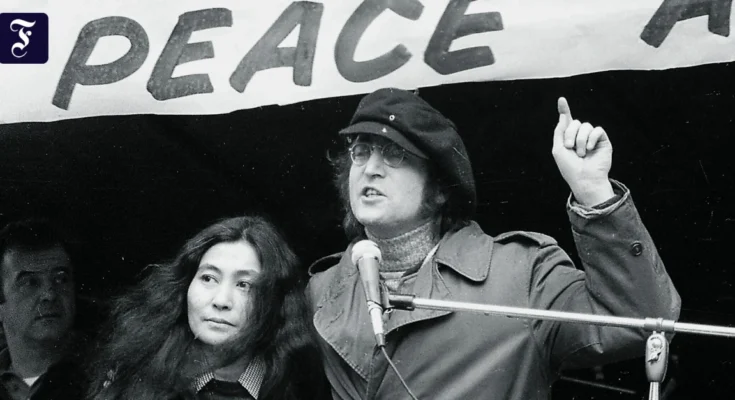A palpable warmth and almost undeniable vulnerability: It was this voice, “a rough northern roar, filled with bluesy groans” – as Beatles biographer Ian MacDonald described it early and with untranslatable precision – with which John Lennon can still touch people’s hearts today. In his sad, poignant tone, there is a deeper reason for his ability to provoke emotionally. He was the one who shouted “Help” and dared to bare his soul. He also dared to fail. And that takes courage in a pop culture filled with a mandatory mania for masculinity.
Of all the British pop stars, Lennon remains the most reminiscent of the ‘angry young man’ archetype. And he probably had Europe’s first honest white rock ‘n’ roll voice. All of this actually became the basis of his ‘credibility’, dignity and credibility which is still unbreakable to this day. Lennon’s often contradictory way of life became his most important political statement. He repeatedly tried demonstratively to reconcile the private and the public, the personal and the political. Yet Lennon remained a troubled “working class hero” who refused to be relegated to mass commodity in an age of cynical superstars.
Slandered as a “splitting witch”
The “Power to the People” box now tells all of these upheavals and triumphs. Not only can the intensity of Lennon’s singing voice be felt here in all its power and purity, the luxurious box set – lovingly assembled and thoughtfully mixed by Sean Ono Lennon – with nine CDs, three Blu-Rays and an extraordinary 200-page volume covers the most politically radical period in the lives of John Lennon and Yoko Ono. When he moved to the United States on September 3, 1971 with his wife, defamed in England as a “splitting witch,” he did not lose his indomitable spirit.
Benefit concerts for the politically persecuted, appearances on angry talk shows, speeches in solidarity with left-wing organizations — he provided ample evidence to the FBI, which had long targeted him, with much evidence of what it deemed “un-American behavior.” Behavioral scientist Desmond Morris correctly suspects that the roots of this creative rage lay in Lennon’s childhood trauma: “His desperate need to convince himself that he was worthy of attention would drive him further and further away.” So his pop slogans and campaign art in the early 1970s can still be understood as a struggle for himself.
In the middle of the “Power To The People” box are two “One To One” concerts by the Plastic Ono Band from August 1971 at Madison Square Garden, backed by the popular Greenwich Village rock band Elephant’s Memory. These are the only two comprehensive live performances Lennon completed in the post-Beatles era – now released in full for the first time. And Lennon’s mouth was always full of “spice and whimsy” that fueled thrilling live versions of “Instant Karma”, “Mother” or “Cold Turkey”.
“What a terrible city!
“New York City” with its Chuck Berry guitar riff and declaration of love for the “Statue of Liberty” exudes high-speed joy. “What a bad town!” shouted John. You can almost feel the fear and tension in his voice, at least in the soaring new version of “Come Together.” There’s the over-the-top “Hound Dog” with Lennon confessing, “Elvis, I love you!” in the last verse. It’s the perfect transition to singing “Give Peace A Chance” with guest vocals from Melanie, Stevie Wonder, and Phil Spector.
Two months earlier, John and Yoko had released their still-controversial album “Some Time In New York City”: a highly political manifesto that, presented like a newspaper page, acted as a kind of “journalistic diary of rebellion” (Lennon). Fueled by an eclectic energy inspired by the counterculture in the Big Apple, with neighbors like Bob Dylan and Allen Ginsberg, the two now prominently wore berets to portray themselves as militant revolutionaries. Musically, their commitment was expressed in speeches of solidarity to imprisoned activists such as John Sinclair and Angela Davis, to the Northern Irish people’s struggle for freedom or to the prisoners in Attica State Prison.
From rough version to full size
It is interesting to hear how each song slowly develops from a raw acoustic version to a full size in an “evolution documentary”. With one exception: Unfortunately, the feminist manifesto “Women are the World’s N*****s”, which may have been overlooked for some reason, is missing. At the time of its release, this confrontational song became one of the album’s highlights. You can definitely choose the sentence “Women are slaves to slaves” as the title.
Fans were compensated by numerous unreleased live recordings – from the “John Sinclair Freedom Rally” in Ann Arbor to the “Attica State Benefit” from the Apollo Theater in Harlem to John and Yoko’s appearance on the David Frost Show in December 1971. The rock ‘n’ roll sessions with Elephant’s Memory, on the other hand, once again documented that Lennon remained a rebel rocker, backing the Beatles’ version of Carl Perkins. “Honey Don’t” might have been a better choice than a well-behaved Ringo Starr.
Unfinished charm
It is Lennon’s fearless range of the box that captivates the listener. Even the fact that thirty-three other pure acoustic classic rock songs were recorded solo using imperfect house jam methods was no impediment to its release. It’s precisely its unfinished charm that makes it worth listening to. In the latter, Lennon’s poisonous slide commentary on National Resophonic guitar on four folk classics by Phil Ochs exudes humor and madness.
However, the “Anthology 4” collection, which is scheduled to collect several Beatles rarities from its nearly endless archives later this month, lacks a willingness to take risks. Unfortunately, the final opportunity to finally present the only truly interesting work from the Beatles collection, the sound collage “Carnival of Lights”, to Fab Four fans for aesthetic evaluation is missed here. Once again, the publication of a John Cage-style serendipitous composition, long considered the “Holy Grail”, failed due to the veto of Olivia Harrison, who, like her late husband George, did not want the Beatles’ aura of friendliness to be damaged by such a radical piece of music.
Yoko Ono would have no problem with such an endeavor. Their screaming screams during a famous jam session with Frank Zappa and the Mothers in June 1971 demonstrated the willingness to take risks and the confidence that today’s Beatles performers crave. In another box set contribution, it makes sense that comedian Jerry Lewis enriches the loopy reggae version of “Give Peace A Chance” with his brilliant amateur trumpet playing. He may have been right when he previously called John & Yoko “two of the most unusual people in the world – and I don’t just mean entertainment” in the “Muscular Dystrophy” telethon in September 1972. By now you almost want to shout to a divided American nation: “Listen to more John & Yoko!”
John & Yoko / Plastic Ono Band: “Power to the People”. (Box set contains 9 CDs, 3 Blu-Rays, book). Mercury Notes 06024/75839668



